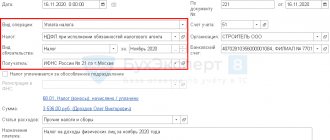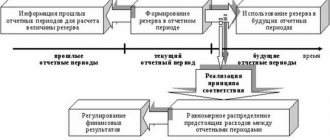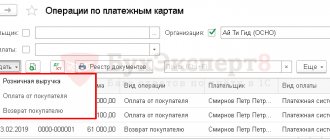Specifics of working with score 58
Account 58 is needed to summarize information on all cash deposits of the enterprise. Since we are talking about assets, account 58 belongs to the category of active accounting accounts. Account turnover is formed as follows:
- the debit part records cash (material) receipts or an increase in their value. Shares contributed to the authorized capital of the enterprise or securities may be indicated here;
- the credit side reflects the disposal or decrease in value. Turnover occurs when the founder leaves the organization, securities are transferred to another authorized capital, loans are repaid, etc.
Analytical accounting for account 58 is carried out in the context of the types of investment objects for which contracts have been concluded. To simplify accounting, all investments are divided into long-term and short-term.
The meaning of position 58 in accounting
The designated account is designed to provide detailed accounting of the company's cash investments.
Analytics for this account is carried out for separate sub-accounts, including:
- 1 – accounting for investments in shares and shares;
- 2 – investing in debt instruments.
Investments of a company or organization are reflected in the debit part 58 of the account and the credit part of those positions where the values that are subject to transfer on account of such investments are recorded. Thus, the company’s purchase of securities of third-party companies is recorded in the debit part of position 58 and the credit part of position 51 or 52.
If an amount is written off that exceeds the purchase price of debt obligations over their nominal price, then the accounting department reflects these funds as a debit of 76 and a credit of 58 positions.
If the company decides to sell existing securities or pay off their value, then these funds are recorded in debit 91 and credit 58 positions.
Accounting entries to account 58
The PBU contains a list of transactions used to display all operations with account 58. Let's look at them in more detail in the table:
| Description | Dt. | Kt. |
| Securities purchased for foreign currency | 58.1 | |
| Bonds were paid from a current ruble account | 58.2 | 51 |
| Loan issued to a third party (materials) | 58.3 | |
| According to the deed of a simple partnership, the fixed asset was given away as a contribution to the authorized capital | 58.4 | 01 |
| Reflection of the difference between the initial and market value of bonds | 58.2 | 91 |
| The cost of purchased shares has been revised taking into account market indicators | 91 | 58.1 |
| Payment by bill | 51 | 58.2 |
| The previously issued loan was returned by bank transfer | 51 | 58.3 |
| The intangible asset transferred under a simple partnership agreement has been returned | 04 | 58.4 |
Wiring cannot be done: D 60 K 58
Financial investments"
58.1 - “Units and shares”;
58.2 - “Debt securities”;
58.3 - “Loans provided”;
58.4 - “Deposits under a simple partnership agreement”, etc.
UNIT - a share of the capital of a company, which gives the right to participate in general meetings of shareholders, to receive dividends and part of the company’s property upon its liquidation. P. is expressed in a specific document - a certificate, to which coupons for receiving dividends are attached.
SHARES are securities issued by a joint-stock company, the owners of which are granted all property and personal rights associated with the ownership of a share: a) the right to receive dividends, depending on the size of the corporation’s profit; b) the right to participate in the management of the corporation by participating in meetings; c) the right to receive part of the property after the liquidation of the corporation. Rights are exercised in an amount proportional to the size of the shares.
D 58 K 51 –
the emergence of a financial investment object is reflected (when transferring or paying for this object from a current account);
D 58 K 76 –
the occurrence of debt to counterparties is reflected (if payment for financial investment objects will be made after obtaining ownership rights to them, for example, in the case of securities).
D 76 K 91 —
D 91 K 58
– reflects the negative difference between the purchase and par value (or between the par and purchase value) of the acquired debt securities.
In account 58, investments are accounted for at actual cost (in the amount of costs incurred for their acquisition).
Financial investments are the second most liquid after cash in hand and in current accounts.
The reserve is formed at the expense of financial results (as part of operating expenses), which is reflected in the accounting entry as a debit to account 91 “Other income and expenses” and a credit to account 59 “Provisions for impairment of financial investments.” A similar entry is made when increasing reserves in the event of a further decrease in the estimated value of financial investments.
The reserve is reduced (used) in the following cases: if the estimated value of the relevant assets in the reporting period has increased, if their value is no longer subject to a sustained significant decrease, as well as upon disposal of these assets. In this case, an entry is made in the debit of account 59 “Provisions for impairment of financial investments” in correspondence with the credit of account 91 “Other income and expenses”.
In the financial statements, financial investments for which an impairment reserve has been created are reflected at their book value less the amount of the reserve.
In the net balance sheet, when reflected in the asset, the difference between 58 and 59 accounts is reflected. Those. There is no account in the liabilities side of balance 59!
Reserve for depreciation of financial investments” (passive, contractual to account 58).
The reserve for impairment of financial investments is created by the following entry:
D 91.2 K 59
D 59 K 91.2 –
reserve amount restored
As soon as financial investments are disposed of, the corresponding reserve amounts are written off to other income of the enterprise (91.1).
Regulatory regulation of the accounting of bills of exchange is carried out by the “Regulations on promissory notes and bills of exchange” dated August 7, 1937.
When purchasing bills of exchange, they are accounted for at actual cost on account 58, disposal is reflected through account 91.
D 60 K 91
– we pay the supplier with a bill of exchange.
Upon disposal of this bill, we will make the following entries:
D 60, 76 K 91.1 1000
D91.2 K 58 900
A credit balance of 100 rubles is formed, and income tax is paid on it.
If we provide a loan, we make the following entries:
D 58 K 51
If our main activity is the purchase and sale of financial investments, then income and expenses are charged to account 90, otherwise - to account 91.
When transferring shares, bills, i.e. When they are disposed of and sold, the following entry is made:
D 90.1, 91.2 K 58
Wiring cannot be done: D 60 K 58
D 76 K 91.1
– interest accrued on loans is reflected;
If the loan is provided to an employee, then interest will be accrued to account 73.
D 73 K 91.1
If we have been accrued dividends on the objects of any financial investments, then we will reflect their receipt by posting:
D 51 K 91.1
58.4 — “Deposits under a simple partnership agreement”
(joint activity of enterprises, which is carried out on the books of one of the enterprises);
When depositing assets, account 58 is used.
Under the simple partnership agreement, funds were deposited from the current account:
D 58 K 51
The following materials were included under the simple partnership agreement:
D 58 K 10
And if we contribute them at a higher price, then the transfer of materials will have to be reflected as follows:
D 58 K 91.1
Subaccounts and analytics
To separately account for amounts received in different currency units, the company’s accountant can open additional sub-accounts for account 58:
- 58.1 – statutory contributions, contributions to joint stock companies;
- 58.2 – investing in securities;
- 58.3 – loans issued to individuals. persons and companies in any form;
- 58.4 – contributions to the general property mass under a simple partnership agreement.
The number of subaccounts is not limited to those indicated, since it is necessary to maintain analytical accounting for each group of objects. An accountant can open other sub-accounts if this is specified in the organization’s accounting policies.
Example of invoice registration 58
engages in the sale of exotic plants. During the first quarter of this year, the company purchased shares worth 10 thousand dollars, and after that it issued a loan in the amount of 200 thousand rubles to a third-party organization supplying turf. At the end of the reporting period, the loan was returned to the current account. The accountant revalued the shares with an increase of 10% at the market rate and generated the following entries:
- Dt. 58.1 – Ct. 52 – 10,000 dollars – shares were purchased for foreign currency.
- Dt. 58.3 – Kt. 51 – 200,000 rubles – loan to a third-party company supplying turf.
- Dt. 91 – Kt. 58.1 – 1000 dollars – revaluation of shares with an increase of 10%.
- Dt. 51 – Kt. 58.3 – 220,000 rubles – loan repayment with interest.
Active and passive accounting accounts - differences
Active and passive accounting accounts are types of accounting accounts, determined based on their function and purpose. In our material, the reader will learn about which accounts are called active and which are passive, and will get acquainted with an example of recording transactions on accounts of different types.
Recording transactions on accounts
In accounting, all business transactions are recorded in the form of accounting entries using special created accounts, each of which is assigned a unique number.
Similar transactions are grouped in separate accounts. The name of the account directly indicates the specifics of the transaction reflected on it.
All changes that directly occur with economic assets and their sources lead to their change in monetary terms.
The list of accounts officially approved in the Russian Federation - Chart of Accounts - is suitable for use in any industry.
For example, an accountant of a furniture factory will take into account lumber and furniture fittings on account 10 “Materials”, an accountant of a legal consultation will take into account pens and paper, etc.
In practice, enterprises use only accounts that correspond to the specifics of the type of activity in which they are engaged. The accounts used by the enterprise constitute the Working Chart of Accounts of the enterprise, which in turn is an integral part of the Accounting Policy.
For information on the accounts used in 2021, see the material “Table of Accounting Accounts in 2016”.
The account has a tabular form: the left side is called “debit”, the right side is called “credit”.
To indicate the balance of an account either at the beginning or at the end of a period, the term “balance” exists.
Accounting accounts are either active or passive. The accounts on the sides of the balance sheet are named and correspond to their contents.
The structure of the accounts is similar (both active and passive accounts have sides called “debit” and “credit”), but the meaning of these sides is different - it is important to remember this.
Active accounts
Active accounts are those that are used to record information about the property of the enterprise. For example: money, including in foreign currency, transfers in transit, own shares.
An increase in funds in an active account is reflected as a debit, and a decrease as a credit. At the end of the period, the balance of the active account is debit.
Active accounts include: 01, 03, 04, 07, 08, 09, 10, 11, 19, 20, 21, 23, 25, 26, 28, 29, 41, 43, 44, 45, 46, 50, 51 , 52, 55, 57, 58, 81, 94, 97.
Shtrabak LLC purchased a laptop. The cost of the laptop is 87,000 rubles. without VAT. The debit of account 01 “Fixed assets” has an opening balance of 0 rubles. The accountant reflected the acceptance of the laptop as a debit, since the account used is active. The final debit balance is RUB 87,000.
Passive accounts
Passive accounts are those that demonstrate methods of forming property (loans provided, contributions from participants, etc.).
An increase in funds is reflected as a credit, a decrease - as a debit. At the end of the reporting period, the balance of the passive account is credit.
The following accounts are considered passive: 02, 05, 42, 59, 63, 66, 67, 70, 77, 80, 82, 83, 96, 98.
The only participant in Shtrabak LLC was granted a loan. Loan in the amount of 150,000 rubles. arrived at the bank account of Shtrabak LLC.
Shtrabak LLC keeps records of settlements for short-term loans on account 66. The initial credit balance on this account is 0 rubles.
The accountant reflected the receipt of 150,000 on the loan, since the account is passive. Loan turnover—RUB 150,000.
In less than a month, 50,000 rubles. were returned to the lender. The accountant completed the posting, and an entry appeared in the debit of account 66 - 50,000 rubles. The total turnover on the debit of the account is 50,000 rubles.
The final credit balance is RUB 100,000.
Active-passive accounts
The following accounts: 14, 15, 16, 40, 60, 62, 68, 69, 71, 73, 75, 76, 79, 84, 86, 90, 91, 99 - can have both a debit and a credit balance.
Accounts in this group are called active-passive.
Balance sheet
The debit balances make up the left side of the balance sheet - the asset, and the credit balances make up the right side of the balance sheet - the liability.
Information about the financial condition of an enterprise in rubles as of a certain date can be obtained through the balance sheet, as well as information about the nature and size of the property.
Information in the balance sheet is grouped into sections, and sections consist of items. Balance is a Latin word and translates to “two cups.” Maintaining equality between assets and liabilities is the main principle of balance.
The sum of all balance sheet asset items (indicators characterizing the organization's economic assets) is equal to the sum of all balance sheet liability items (indicators characterizing the sources of economic assets).
Balance sheet data is used to control the amount of economic assets, their structure, sources, analyze the financial condition of the organization, and its solvency. The main form of accounting reporting, which is provided to regulatory authorities and interested users (banks, counterparties), is the balance sheet.
Results
and passive accounts used in accounting are included in the Working Chart of Accounts of the enterprise, approved by the manager. This document is considered a mandatory component of the accounting policy of the enterprise.







